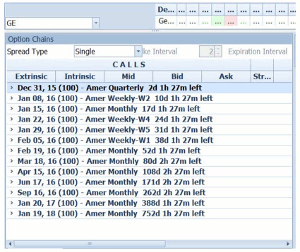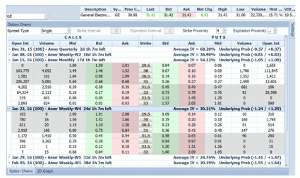As a follow-up to his article regarding the different options expiration dates that exist for options on stocks and ETFs, options instructor Russ Allen, of Online Trading Academy, goes into further detail regarding how they relate to bid-ask spreads.
Last week, I discussed the various options expiration dates that exist for options on stocks and ETFs. We’ll continue with that discussion today.
We started with an option chain for the stock of General Electric Corp. (GE). Here’s how that chain looks as of last Tuesday (December 29, 2015), with just the expiration dates exposed:
The chain shows a typical array of expiration dates, which include:
Monthly options expiring on these dates in 2016:
- January 15
- February 19
- March 18
- April 15
- June 17
- September 16
Quarterly options expiring on:
- December 31, 2015
Weekly options expiring in 2016 on:
- January 8
- January 22
- January 29
- February 5
You’ll note that there are holes in the list of weekly options above…there are no weeklies for December 31, 2015 (because there is already a Quarterly option for that date) or for January 15 (because there is already a Monthly for that date). That’s the way it works, weeklies are filled in only where needed to provide an option that expires at the end of each of the next six weeks. Where another type already exists, there is no need for a weekly option.
I briefly mentioned last week that one of the criteria for selecting one expiration date over another is the bid-ask spread for the options. Below is the GE options chain with the lists expanded for the options expiring on January 15 (a monthly option) and January 22 (a weekly options):
Let’s focus on the options at the strike price closest to the current price of GE, which was $30.90. That strike would be $31.00, which we would call the at-the-money strike (ATM).
For the January 15 options, the 31 Calls have a Bid of $.68 and an Ask of $.69. This means that if we wanted to buy one of these calls we would pay $.69 per share (the Ask price), and if we wanted to sell one, we could get $.68 per share for it (the Bid price). The difference is $.01 per share.
The January 15 31-strike Puts also show a spread of $.01, with a Bid and Ask of $.26 and $.27.
Now look at the Puts that expire a week later, on January 22. The 31 calls have a nine-cent spread ($.75 X $.84) while the puts have a seven-cent spread ($.36 X $.43). Seven or nine cents, compared to one cent for the monthlies.
It is pretty obvious why a large spread is not good for the option trader. When we want to buy an option, we must buy it from someone who is willing to sell it to us. The Ask price is the lowest price at which anyone is willing to commit to sell. Although we can always try, using limit-type orders, to buy at a price lower than the Ask, there is no assurance that such an order will be filled.
Likewise, when we want to sell, someone must buy our option from us. There is no assurance that we will be able to sell for a price any higher than the Bid. That is the highest price at which anyone is currently willing to commit to buy.
NEXT PAGE: Useful Midpoint to Think About
|pagebreak|Both the Bid and the Ask prices change constantly, as the three main forces act on the options: stock price movement, passage of time, and changing market expectations. We hope and plan, of course, that these forces will move the option price in the direction that will be profitable for us. But win or lose, eventually the option position will need to be closed out.
It is useful to think of the midpoint between the Bid and the Ask prices of an option as its true, or fair, value. This is also called the mark. When we pay more than that, the excess can be thought of as the option market maker’s markup, or profit margin. And when we sell, if the price we receive is less than the mark, than any shortfall is also the market maker’s profit margin. That markup goes out of our pocket and into that of the market maker.
So if we end up, as will often be the case, buying at the Ask and selling at the Bid, the difference between that Bid and Ask is a cost to us, paid in the form of a market-maker’s markup. We paid half the spread when we entered the trade (since the fair value was midway between the Bid and the Ask), and the other half when we exited. The smaller that markup is, the better for us.
Option market makers make their living by taking the other side of the trades made by traders and investors. The market makers buy from us at the Bid, or sell to us at the Ask. The wider the difference between the Bid and Ask, the better it is for the market makers and the worse it is for us.
Market makers would always like to maintain a wide spread, and will adjust their Bid and Ask prices to keep it as wide as they can while still getting some business. When few investors or traders are active in a particular option, the market makers have no competition and therefore no reason to keep spreads narrow. If there are many active traders and many contracts changing hands, the market makers will have to settle for bid and ask prices closer to the mark in order to do any business.
In our example above, note that the open interest for the Jan 15 Monthly 31 calls was over 205,000 contracts, while for the January 22 weekly calls it was just 2,900 contracts. This huge disparity is typical, since the weekly options have a much narrower audience. By definition, only short-term traders deal with instruments with such a limited lifespan, while all kinds of traders and investors can use the longer-lived ones. This explains why the spread for the weekly options is almost always much larger than the monthlies.
And that, in turn, explains why for many purposes, the monthly options are the best choice. Exceptions would be:
Where the weekly options are so widely used that their spreads are not much worse than monthlies. This applies to some of the large equity index ETFs like SPY and QQQ.
Where the strategy is to sell out-of-the-money options short and not buy them back, so that one-half the spread is paid only once (going in, but not coming out). If stops are used, these could still incur the full spread, however.
This completes our discussion of option expirations as they relate to bid-ask spreads. I hope this helps you in your selection of options for your strategies.
By Russ Allen, Instructor, Online Trading Academy























